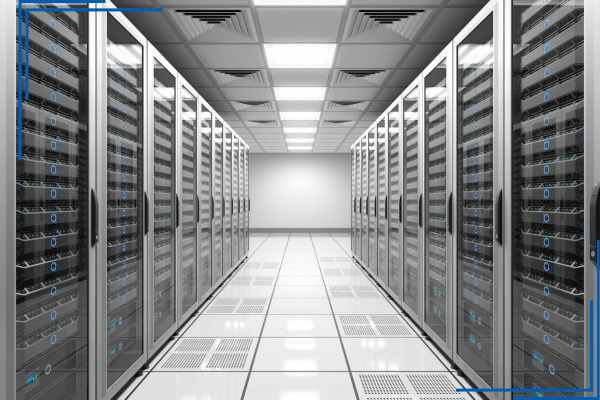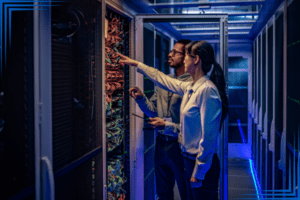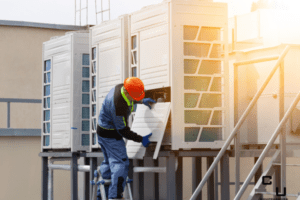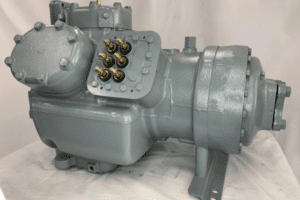Data centers are the backbone of modern industry, storing vast amounts of data and processing complex operations. But with this power comes a challenge: data centers generate significant heat, and managing this is essential for both safety and efficiency. Proper cooling ensures equipment longevity, minimizes downtime, and protects against data loss. Below are several essential tips for HVAC/R technicians to help maintain optimal cooling in data centers.
1. Implement Hot and Cold Aisle Containment
Hot and cold aisle containment is a popular layout strategy that helps maximize cooling efficiency. By organizing server racks in alternating hot and cold aisles, HVAC/R technicians can prevent hot exhaust air from mixing with the cold intake air. The separation keeps temperatures steady and reduces the energy needed for cooling. By using this containment strategy, data centers can reduce cooling loads and prevent hotspots, ensuring consistent performance across all equipment.
2. Explore Economizer Cooling Options
In cooler climates, economizers are a great option for lowering operational costs. These systems utilize the natural outdoor temperature to cool indoor spaces, a process known as “free cooling.” When the outdoor temperature is below the data center’s set threshold, economizers can bring in cool air or circulate it through cooling coils, reducing the need for mechanical cooling. This energy-efficient approach can provide substantial savings, although data centers in warmer climates may require additional cooling support.
3. Invest in Liquid Cooling Techniques
Liquid cooling has emerged as an effective method for data centers, especially as servers become more compact and powerful. This method involves circulating a cooling liquid near or directly on high-heat components like CPUs. There are two primary types of liquid cooling used today:
- Direct-to-Chip Cooling: Liquid flows through tubes to the hottest part of the device, often the CPU, where it absorbs heat before circulating back to a cooling reservoir. This method is efficient, allowing high-density data centers to cool specific hotspots.
- Immersion Cooling: In this method, devices are submerged in a dielectric fluid that absorbs heat. The fluid heats up, evaporates, then condenses back into a liquid to restart the cooling cycle. This method is ideal for environments with high computing demands and limited space, as it eliminates the need for air conditioning units.
For HVAC/R technicians, understanding these systems is crucial for recommending the best options for each facility’s unique needs.
4. Schedule Regular Maintenance and Cleaning
Preventative maintenance is key to keeping any data center cooling system running efficiently. Dust and debris can quickly accumulate on filters, vents, and coils, blocking airflow and causing cooling inefficiencies. Regularly checking and cleaning cooling components helps maintain consistent airflow and prolongs the life of HVAC equipment. Additionally, technicians should inspect the condition of seals, containment barriers, and ducts to ensure optimal airflow within the data center.
5. Optimize Airflow Management
Data center airflow management goes beyond just hot and cold aisle containment. Additional steps, such as using blanking panels in unused server rack spaces, can prevent air from recirculating within racks. Perforated floor tiles placed strategically around cooling zones can also help channel cold air where it’s needed most. Airflow optimization minimizes the work that HVAC systems need to do and can reduce operating costs significantly.
6. Upgrade Outdated Equipment
As HVAC/R equipment ages, it becomes less efficient, often requiring more energy to produce the same cooling output. Upgrading to modern, energy-efficient units can reduce operating costs, enhance cooling capacity, and provide more precise temperature controls. Data centers with outdated systems or commercial compressors that may need replacing may experience increased downtime, impacting productivity and reliability. Regular assessments allow facilities to make proactive upgrades before older units fail.
7. Use Advanced Monitoring and Automation
Real-time monitoring technology has become indispensable in modern data center cooling. By implementing IoT sensors and integrating artificial intelligence (AI) software, HVAC/R technicians can monitor temperature fluctuations, energy usage, and airflow distribution continuously. This proactive monitoring allows technicians to detect potential issues early, schedule maintenance when needed, and optimize cooling based on real-time data. AI-based automation systems can also adjust cooling loads dynamically, ensuring that each part of the data center remains at optimal temperatures.
8. Consider Geothermal and Evaporative Cooling Systems
Alternative cooling methods, such as geothermal and evaporative cooling, can provide efficient cooling in specific conditions:
- Geothermal Cooling: Using the natural cooling power of the earth, this system circulates a coolant through underground pipes. As the coolant moves, it absorbs the earth’s cool temperature and brings it back to the data center, where it can dissipate heat from servers. This method can reduce electricity consumption and is ideal for data centers located in areas with suitable soil and geological conditions.
- Evaporative Cooling: This technique involves passing air over water-soaked pads to create cool, humid air. The process uses minimal energy and can be an effective option for data centers in dry climates. However, it’s important to consider the impact of humidity on sensitive equipment and to use evaporative cooling in conjunction with other humidity control methods.
9. Ensure Redundancy and Backup Systems
Cooling systems in data centers are crucial for preventing outages and safeguarding data. Any failure in the cooling system can lead to overheating and damage to critical equipment. Redundancy, such as backup CRAC (Computer Room Air Conditioning) units and additional chillers, is essential for continuous operation. HVAC/R technicians should prioritize regular testing of backup systems to ensure they’re ready to perform in case of a primary system failure.
Data center cooling is a complex and evolving field, and implementing the right strategies can make a significant difference in efficiency, cost savings, and data integrity. HVAC/R technicians play a pivotal role in designing and maintaining these systems, ensuring that data centers can continue to support critical operations without the risk of overheating. By adopting these tips, technicians can help their clients maintain optimal cooling while driving down operational costs and enhancing system reliability.












